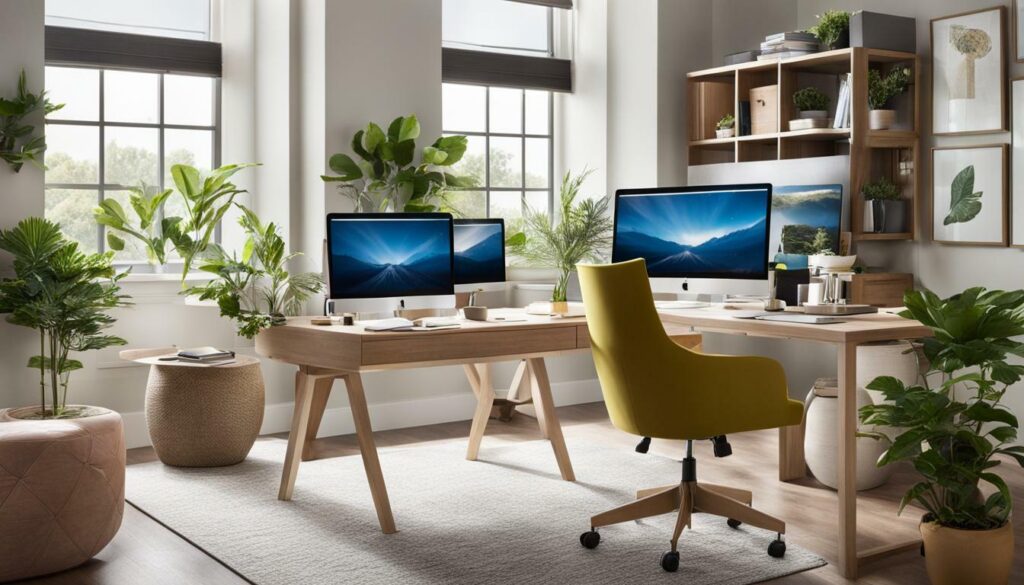A Comprehensive Guide to WFH Mental Wellness

Welcome to our Comprehensive Guide to WFH Mental Wellness, where we explore the essential strategies and tips to maintain your mental health while working remotely in the UK. Working from home (WFH) has become more common due to the COVID-19 pandemic, and it can have both benefits and challenges for mental wellness. To help maintain mental health in a remote working environment, it is important to establish a routine, set boundaries, and create a dedicated workspace. Taking breaks, staying connected with colleagues, and engaging in physical exercise can also contribute to wellness. Additionally, considering long-term improvements, such as optimizing the work environment and exploring new ways of connecting online, can enhance well-being. It is crucial to recognize and address the specific needs and challenges of different types of remote workers, whether they are workaholics, daydreamers, or individuals struggling with loneliness. By implementing these strategies, individuals can support their mental wellness while working from home.
Key Takeaways
- Establish a routine and set boundaries to maintain a healthy work-life balance.
- Create a dedicated workspace with suitable furniture, lighting, and ergonomic setup.
- Take regular breaks and engage in physical exercise to support mental well-being.
- Stay connected with colleagues through virtual communication to prevent feelings of isolation.
- Consider long-term improvements to enhance your remote working experience.
Understanding the WFH Environment
Working from home can blur the lines between work and personal life, making it crucial to understand the WFH environment and implement strategies that promote mental wellness. While remote work has its advantages, such as increased flexibility and reduced commute time, it also comes with its own set of challenges. Without the physical separation of a traditional office, it can be difficult to maintain a healthy work-life balance.
It’s essential to establish a routine that mimics a typical workday. This can help create a sense of structure and signal the start and end of the workday. Set clear boundaries by designating a specific workspace in your home. This can be a separate room or even a corner of a room, as long as it’s solely dedicated to work. Having a designated workspace can help create a mental distinction between work and personal life, promoting a healthier work-life integration.
One way to illustrate this is through the following quote: “The WFH environment can be both a blessing and a curse. While it offers the freedom to work from the comfort of your own home, it also blurs the lines between work and personal life. By establishing a routine and setting boundaries, you can create a psychological separation that enhances your mental well-being.”
Additionally, it’s important to take regular breaks throughout the day. Step away from your workspace, stretch your legs, and give your mind a chance to recharge. Disconnecting from work during these breaks is equally important. Engage in activities that bring you joy or help you relax, whether it’s reading a book, going for a walk, or practicing mindfulness. Remember, a healthy work-life balance is key to maintaining good mental health in a remote working environment.

Key Points:
- Establish a routine to maintain a sense of structure and work-life balance.
- Create a designated workspace to mentally separate work and personal life.
- Take regular breaks and disconnect from work to recharge your mind.
Overall, understanding the WFH environment is crucial for promoting mental wellness. By implementing strategies such as routine establishment, boundary setting, and regular breaks, individuals can navigate the challenges of remote work while maintaining their mental health and well-being.
The Importance of Routine and Boundaries
Maintaining a routine and setting boundaries are key factors in ensuring WFH mental wellness, as they help create structure and maintain a healthy work-life balance. When working from home, it can be tempting to blur the lines between work and personal life, leading to feelings of overwhelm and burnout. By establishing a consistent routine, you can create a sense of normalcy and better manage your time.
“A well-thought-out routine can be the anchor that keeps you grounded amidst the chaos of remote work,” says Dr. Emma Stevens, a mental health expert.
Having a routine not only helps you stay organized, but it also signals to your brain that it’s time to focus and be productive. Start your day by setting clear goals and prioritizing tasks to maintain a sense of purpose. Incorporate regular breaks into your schedule to give your mind and body time to recharge. Remember, breaks are not a sign of laziness but rather a necessary part of maintaining productivity and mental well-being.
Furthermore, setting boundaries is crucial to prevent work from encroaching on your personal life. Clearly define your working hours and communicate them to your colleagues and clients. Avoid the temptation to respond to work-related emails or messages outside of those hours. Remember, your mental health and quality of life are just as important as your work commitments.
To maximize the benefits of routine and boundaries, it’s essential to create a dedicated workspace. Designate a specific area in your home where you can focus and separate yourself from distractions. Keep your workspace tidy and organized, with proper lighting and ergonomic furniture to promote productivity and comfort. By creating a physical distinction between work and personal space, you can better maintain boundaries and switch off from work at the end of the day.

Summary:
- Maintaining a routine and setting boundaries are crucial for WFH mental wellness.
- A well-planned routine provides structure and helps you stay focused and productive.
- Set clear goals, prioritize tasks, and incorporate regular breaks into your schedule.
- Establish boundaries to prevent work from encroaching on your personal life.
- Create a dedicated workspace that promotes productivity and allows for a clear separation of work and personal space.
Creating an Optimal Workspace
A well-designed and comfortable workspace is crucial for maintaining mental wellness while working from home. Here are our top tips for creating an optimal workspace that suits your needs:
- Choose the right furniture: Invest in a supportive chair and a sturdy desk that is at the correct height for your posture. Avoid lounging on the sofa or working from bed – having a designated workspace will help create a boundary between work and relaxation.
- Optimize lighting: Natural light is best for productivity and mood. Position your desk near a window if possible, but be mindful of glare. If natural light is limited, use a desk lamp that provides warm, indirect lighting to reduce eye strain.
- Ergonomic setup: Ensure your computer screen is at eye level to minimize neck and back strain. Use a separate keyboard and mouse to maintain a comfortable typing position. Consider using a standing desk or an adjustable desk converter to alternate between sitting and standing throughout the day.
- Personalize your space: Surround yourself with items that inspire and motivate you. Add plants, artwork, or meaningful objects to create a positive and uplifting atmosphere. Keeping your workspace clutter-free can also contribute to a clear and focused mind.
Remember, everyone’s ideal workspace may vary, so experiment and find what works best for you. Find inspiration from others, but ultimately, create a space that reflects your unique personality and promotes productivity.

Taking Breaks and Disconnecting
Taking breaks and disconnecting from work at appropriate times are essential for recharging your mind and maintaining mental wellness. Here are some effective strategies to incorporate breaks and relaxation into your WFH routine:
- Schedule regular breaks: Break up your workday into manageable chunks and schedule short breaks throughout. Get up, stretch, and give your eyes a break from the screen. Taking a few minutes every hour to move and breathe can do wonders for your productivity and mental well-being.
- Engage in mini mindfulness sessions: Take a moment to disconnect and practice mindfulness. Close your eyes, focus on your breath, and let go of any stress or tension. Even just a few minutes of mindfulness can help you feel refreshed and refocused.
- Step outside and get some fresh air: Take advantage of your flexible work environment and go for a walk or sit in your garden during your breaks. Fresh air and nature can have a positive impact on your mood and overall well-being.
- Set boundaries with technology: It’s important to disconnect from work and technology at the end of the day. Establish clear boundaries and avoid checking emails or work-related messages outside of your designated work hours. This will allow you to truly unwind and recharge for the next day.
Remember, taking breaks and disconnecting not only benefits your mental health, but it also improves your overall productivity and focus. Incorporate these strategies into your WFH routine to create a healthier work-life balance.
Image: ![Taking Breaks and Disconnecting Taking Breaks and Disconnecting]()
Staying Connected with Colleagues
Building and maintaining connections with colleagues is crucial for fostering a sense of belonging and combating the potential isolation that comes with working from home. Here’s how you can stay connected with your colleagues while working remotely.
1. Embrace virtual communication: Take advantage of technology to stay connected with your colleagues. Schedule regular video calls or virtual meetings to catch up, collaborate, and maintain a sense of camaraderie. Use platforms like Zoom or Microsoft Teams to ensure effective and efficient communication.
“Virtual communication is the new water cooler chat. Embrace the chat function, exchange funny gifs, and participate in virtual team-building activities. It’s a great way to stay connected and keep the office banter alive!”
2. Create virtual social interactions: Just because you’re not physically in the office doesn’t mean you can’t have social interactions with your colleagues. Organize virtual coffee breaks, lunchtime hangouts, or even after-work happy hours to maintain social connections. It’s a great way to bond, share experiences, and unwind together.
3. Collaborate and support: Stay connected by collaborating on projects and offering support to your colleagues. Share ideas, provide feedback, and offer assistance when needed. By working together, you’ll not only stay connected but also create a supportive and productive work environment.

Embracing Physical Exercise
Regular physical exercise not only improves your physical health but also has a positive impact on your mental well-being. Discover the best ways to embrace physical exercise while working from home to enhance your overall wellness.
Working from home can often lead to a sedentary lifestyle, so it’s important to incorporate exercise into your daily routine. Whether it’s a brisk walk before starting your workday or a lunchtime yoga session, finding ways to move your body can help boost your energy levels and improve your mood.
One effective way to stay active while working from home is to create an exercise schedule. Set aside specific times each day for physical activity and stick to them. This could include a morning jog, an afternoon workout session, or an evening dance class. Not only will this help you stay accountable, but it will also give you something to look forward to during your work breaks.
Additionally, consider incorporating different types of exercise into your routine. From cardio workouts to strength training, mixing up your activities can keep things interesting and prevent boredom. You can also take advantage of online fitness classes or virtual workout sessions with friends to add a social element to your exercise routine. Remember, exercising not only benefits your physical well-being, but it also reduces stress, increases productivity, and promotes a positive mindset.

Embrace the Power of Physical Exercise
“Exercise is the key to a healthy mind and body. By incorporating regular physical activity into your work from home routine, you can boost your well-being and maintain a positive mindset.”
– Fitness expert Emma Smith
Incorporating physical exercise into your work from home routine is essential for your mental wellness. By embracing the power of movement, you can improve your overall well-being and maintain a positive mindset. So, let’s get active and prioritize our health, one workout at a time!
Long-Term Improvements: Enhancing WFH Mental Wellness
As remote work becomes more prevalent, considering long-term improvements to enhance your WFH mental wellness is crucial. Learn how to optimize your work environment and leverage new online tools and platforms for better connectivity and satisfaction.
Creating an ideal work environment is essential for productivity and well-being. Choose furniture that promotes good posture and invest in proper lighting to reduce eye strain. “A well-designed workspace is like a good cup of tea. It sets the mood and makes everything better,” says interior designer Emma Smith. Ergonomic accessories like an adjustable chair and a standing desk can also contribute to your comfort and help prevent health issues.

The key is finding a balance between personal and professional spaces to maintain a healthy work-life integration. Designate a specific area for work, separate from your living space, to create a psychological boundary,” suggests workplace psychologist Dr. Sarah Thompson. “This separation can help you switch off from work mode, relax, and recharge.”
Additionally, explore new online tools and platforms for improved connectivity and collaboration with colleagues. Invest time in attending virtual team-building activities, webinars, or industry conferences. Virtual communication channels such as video conferences and instant messaging can also help foster a sense of connection and reduce feelings of isolation. “Connecting online doesn’t have to be impersonal,” says digital marketing strategist James Davies. “With the right tools and a bit of creativity, you can create engaging and meaningful interactions that mimic face-to-face encounters.”
Optimizing your work environment and embracing new digital solutions are essential for long-term improvements in WFH mental wellness. By prioritizing your well-being, you can enhance your productivity and satisfaction while working remotely.
Addressing Specific Needs and Challenges
Remote workers come in different forms, each with their own unique needs and challenges. Discover how to address the specific needs of workaholics, daydreamers, and those struggling with loneliness to ensure their WFH mental wellness.
For workaholics:
- Set clear boundaries between work and personal life. Establish specific working hours and stick to them. Remember, overworking can lead to burnout and negatively impact your mental health.
- Take regular breaks to recharge and prevent fatigue. Use this time to engage in activities you enjoy, such as reading a book, going for a walk, or practicing mindfulness.
- Delegate tasks and ask for help when needed. Remember, you don’t have to do everything on your own. Distributing workload can help alleviate stress and improve your overall well-being.
For daydreamers:
- Create a structured schedule with specific goals and deadlines. Breaking down tasks into smaller, manageable chunks can help you stay focused and motivated throughout the day.
- Eliminate distractions by turning off notifications on your phone and closing unnecessary tabs on your computer. Consider using productivity tools that block certain websites or apps during designated work periods.
- Experiment with different work environments to find the one that suits you best. Some daydreamers thrive in quiet spaces, while others find background noise or music helpful for concentration.
For those struggling with loneliness:
- Stay connected with colleagues through virtual communication platforms. Schedule regular video calls or virtual coffee breaks to maintain a sense of social interaction and support.
- Join online communities or forums related to your industry or hobbies. Engaging with like-minded individuals can help combat feelings of isolation and provide a sense of belonging.
- Take advantage of online networking events or webinars to expand your professional network and form new connections. Building relationships with others who share similar interests can reduce feelings of loneliness.
Remember, addressing the specific needs and challenges of remote workers is crucial for maintaining WFH mental wellness. By implementing these strategies, workaholics, daydreamers, and those struggling with loneliness can support their mental health and well-being while working from home.

Congratulations on completing our Comprehensive Guide to WFH Mental Wellness!
By implementing the strategies and tips discussed throughout this article, you can proactively support your mental wellness while working from home and enjoy a fulfilling remote working experience. The COVID-19 pandemic has brought about significant changes in the way we work, and it is crucial to prioritize our mental health in this new environment.
Establishing a routine and setting boundaries are key to maintaining a healthy work-life balance. Creating a dedicated workspace can also help separate work from personal life and promote productivity.
Remember to take regular breaks and disconnect from work to avoid burnout. Staying connected with colleagues through virtual communication channels can combat feelings of isolation and foster a sense of belonging.
Engaging in physical exercise is not only beneficial for your physical health but also for your mental well-being. Incorporating exercise into your daily routine can boost your mood, reduce stress, and increase productivity.
Additionally, considering long-term improvements such as optimizing your work environment and exploring new ways of connecting online can further enhance your remote working experience.
Lastly, it is important to recognize and address the specific needs and challenges that different types of remote workers may face. Whether you are a workaholic, a daydreamer, or someone struggling with loneliness, there are strategies and tips tailored to support your mental wellness.
With these insights and recommendations, you are now equipped to navigate the world of remote work with a focus on your mental wellness. Remember, prioritizing your well-being is essential for sustained productivity and overall satisfaction in your remote working journey.

